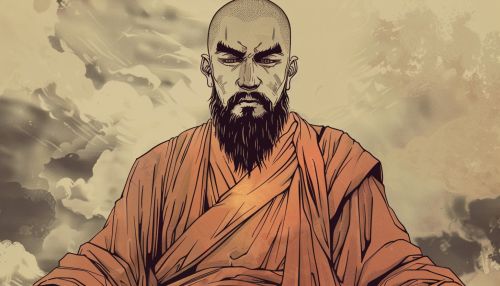Bodhidharma
Early Life and Background
Bodhidharma, traditionally credited as the transmitter of Zen (Chán) to China, is a central figure in the history of Buddhism. His origins are shrouded in mystery, with various sources providing differing accounts of his life. According to some traditions, Bodhidharma was born in the southern part of India, possibly in the region of Kanchipuram in the Pallava dynasty. He is believed to have been the third son of a Brahmin king, which would have afforded him a privileged upbringing and access to extensive religious and philosophical education.
Journey to China
Bodhidharma's journey to China is a subject of both historical and legendary narratives. It is generally accepted that he traveled by sea, arriving in the southern Chinese kingdom of Liu Song around the early 5th century. His arrival marked the beginning of a significant cultural and spiritual exchange between India and China. Bodhidharma's mission was to spread the teachings of Mahayana Buddhism, particularly the practice of dhyana (meditation), which later evolved into the Chán school in China and Zen in Japan.
Teachings and Philosophy
Bodhidharma's teachings emphasized direct experience and personal realization over scholarly study and ritual. He is often associated with the concept of "wall-gazing" meditation, a form of intense, seated meditation aimed at achieving a state of profound inner stillness and insight. This practice is believed to have been influenced by the Yogacara school of Indian Buddhism, which focuses on the nature of consciousness and the process of perception.
Four Practices
Bodhidharma outlined four essential practices for attaining enlightenment:
1. **Practice of the Precepts**: Adhering to the moral and ethical guidelines of Buddhism. 2. **Practice of Meditation**: Engaging in deep, contemplative meditation to understand the nature of mind. 3. **Practice of Patience**: Cultivating patience and endurance in the face of difficulties and suffering. 4. **Practice of Wisdom**: Developing insight into the true nature of reality, transcending dualistic thinking.
Encounter with Emperor Wu of Liang
One of the most famous stories about Bodhidharma involves his meeting with Emperor Wu of Liang. The emperor, a devout Buddhist, asked Bodhidharma what merit he had gained from his extensive support of Buddhist institutions and practices. Bodhidharma's response, "No merit," shocked the emperor and highlighted the Chán emphasis on direct experience over external acts of piety. This encounter is often cited as a pivotal moment in the development of Chán Buddhism, illustrating the school's radical departure from conventional religious practices.
Legacy and Influence
Bodhidharma's influence on Chinese Buddhism cannot be overstated. He is credited with founding the Shaolin Monastery, where he introduced a form of physical training that later evolved into Shaolin Kung Fu. This integration of physical and spiritual practice became a hallmark of Chán Buddhism. Bodhidharma's teachings also laid the groundwork for the development of the Platform Sutra, an essential text in Chán Buddhism attributed to the Sixth Patriarch, Huineng.


Textual Sources and Historical Debates
The primary sources of information about Bodhidharma's life and teachings are found in various Chinese texts, such as the "Record of the Transmission of the Lamp" (Jingde Chuandeng Lu) and the "Anthology of the Patriarchal Hall" (Zutang Ji). These texts, however, were written centuries after Bodhidharma's time, leading to debates among scholars regarding their historical accuracy. Some scholars argue that Bodhidharma's story has been mythologized, blending historical facts with legendary elements to create a more compelling narrative.
Iconography and Symbolism
Bodhidharma is often depicted in Buddhist art as a fierce, bearded monk, sometimes with a single sandal, symbolizing his itinerant lifestyle and dedication to spreading the Dharma. His stern expression and intense gaze reflect the rigorous discipline and uncompromising nature of his teachings. In Japanese Zen art, Bodhidharma is frequently portrayed in humorous or exaggerated forms, emphasizing the paradoxical and non-conformist aspects of his character.
